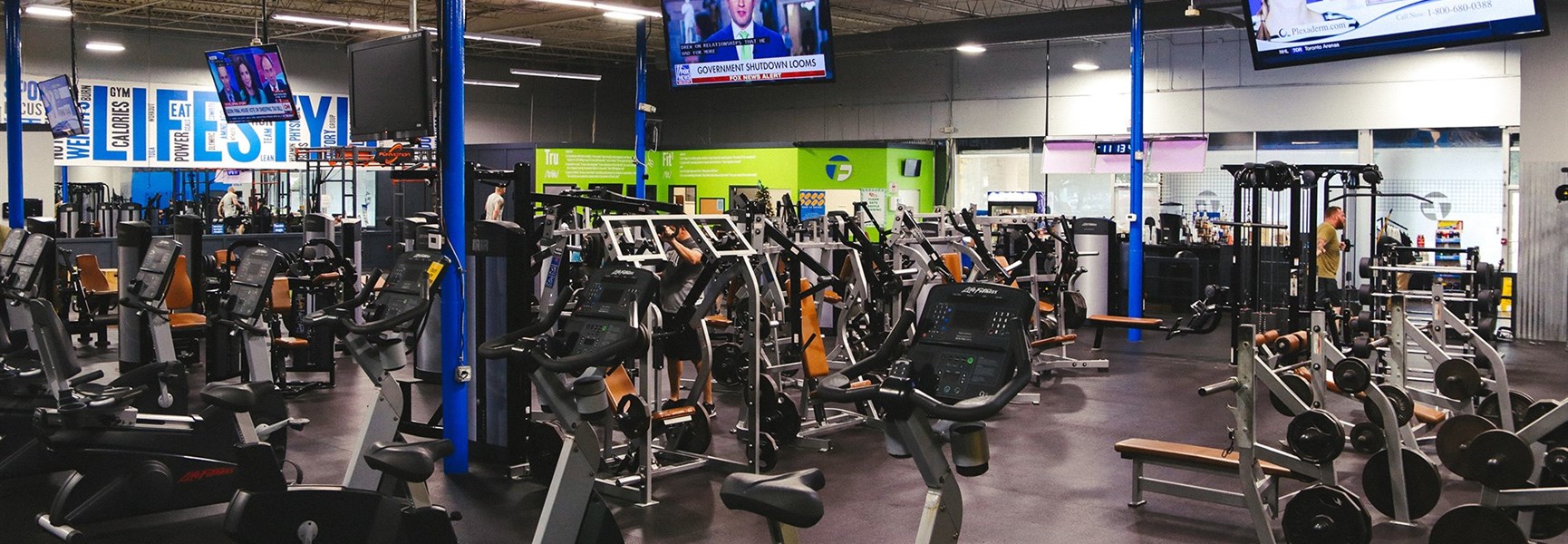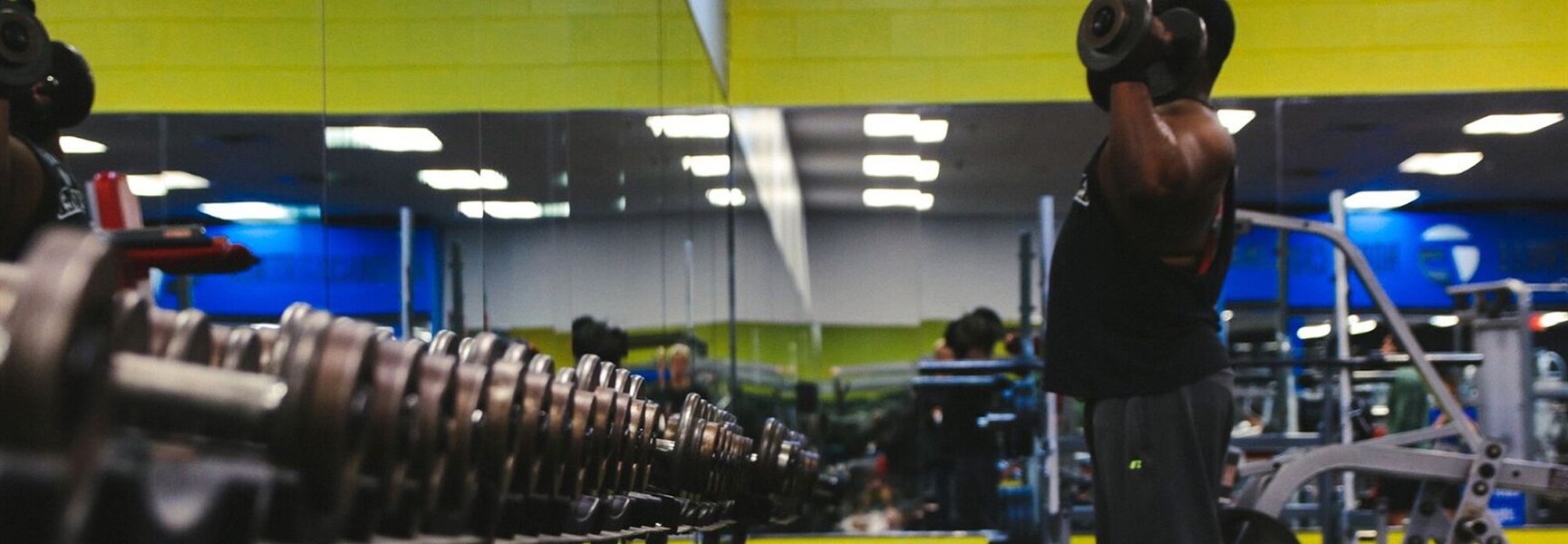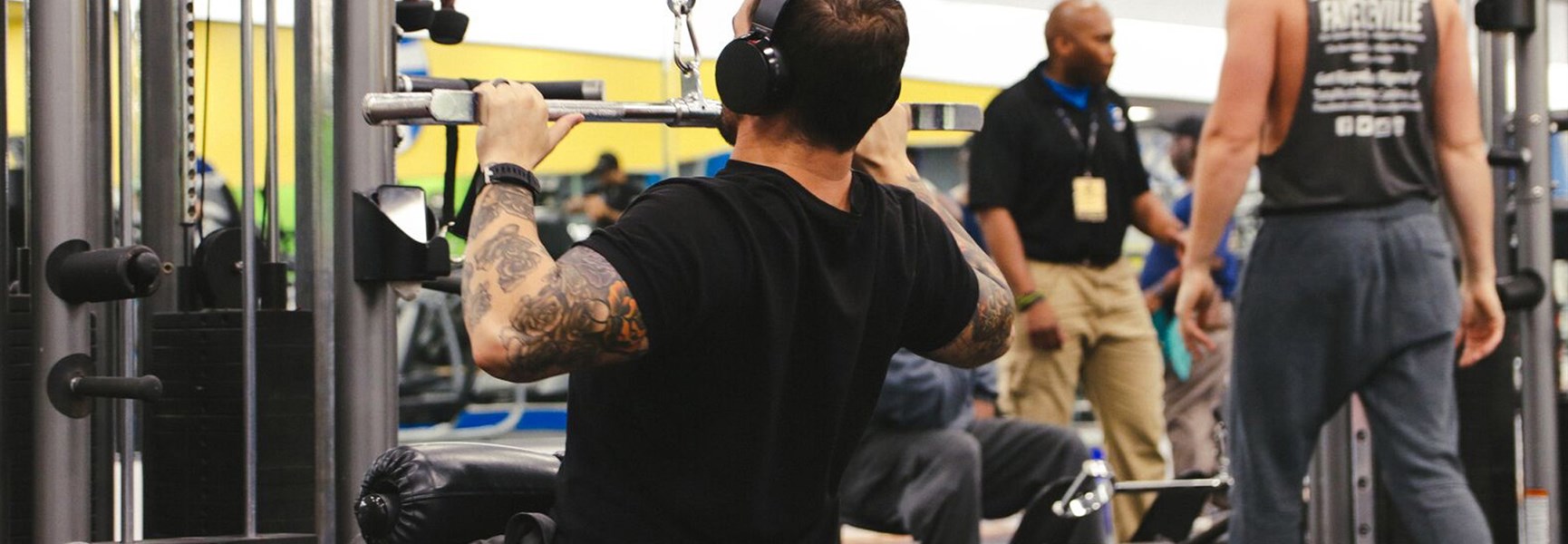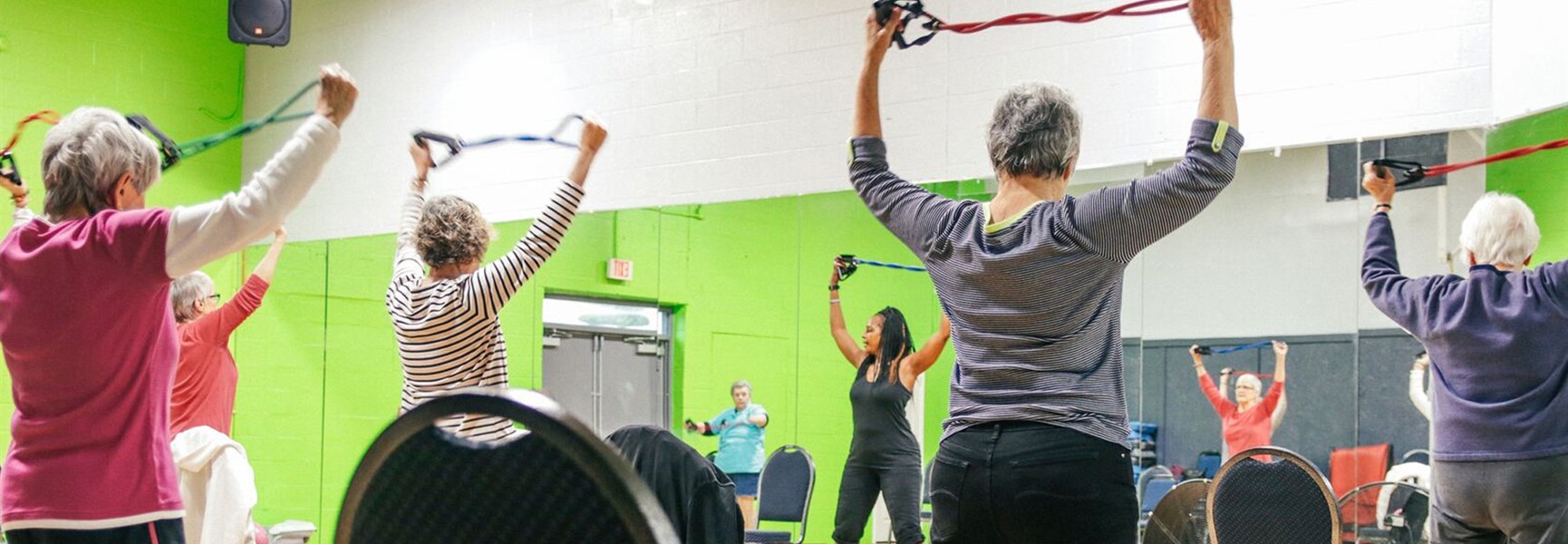
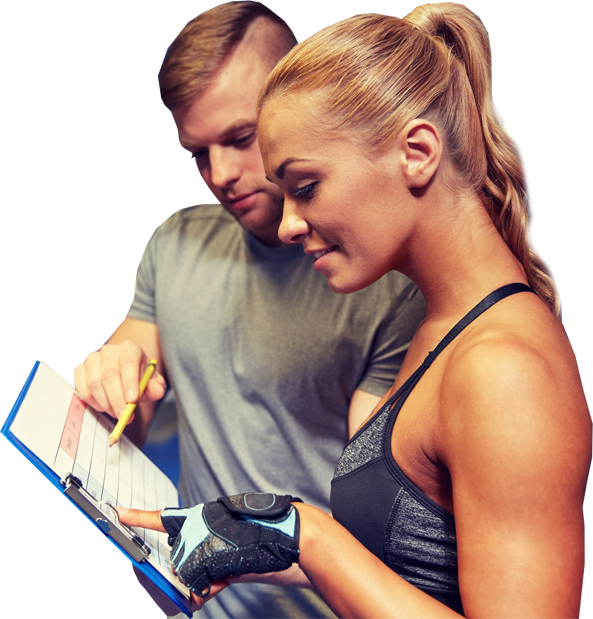
I am new to fitness. Do you offer introductory classes?
ANSWER:
All our classes offer a Smart Start, so if you are new, we only recommend that you do about 20-30 minutes of the class. The instructor will normally let new people know when they can leave. As you develop more endurance, you can add a track here and there and before you know it you will be able to hang on for the entire class.


Can we get a guest pass or a pass for a friend to come in and visit?
ANSWER:
You are welcome to bring a friend to class at any time! Our Guest policy for trying out the gym complimentary is for LOCAL RESIDENTS, Frist Time Guest, 18 years or older. Daily workouts are available for anyone @ $12/day for full use of the gym. We do not have any discounted rates for classes. Joining gets you into all of the classes, kids care, a fitness assessment, and many other things.


Can I bring my kids to class?
ANSWER:
We have special kids classes offered. Programs vary by location. Ask the front desk staff for details. Children are welcome to come to other classes as long as they have a membership. Typically, the membership is for kids ages 11 and up. If your child would like to take a class with us, please try to be in class a little bit ahead of time so that we can make sure that he or she is using the appropriate equipment and weight size for their age.


What is an example of something good to eat before and after I exercise?
ANSWER:
Before a workout, a mix of simple and complex carbohydrates works best. This will ensure your release of energy is slow and steady throughout your workout. Carbohydrates provide energy and that is exactly what you need to get you through your workout and perform at your best.
After you exercise, your body is in recovery mode. It is essential to choose a nutrient rich dish containing protein. The lean protein and carbohydrates in chicken or a TruFit protein shake will help with muscle reparation and recovery from your workout.


How can I test my Body composition?
ANSWER:
We use the Inbody 270 which is a measurement tool that uses the science of bioelectrical impedance. It is very accurate and within 1-2% if you follow the suggested protocol of no food for 1 hour and no exercise prior to the test and being well hydrated while taking the test.
• The initial test will allow us to measure your body fat, body water
• The segmental lean analysis helps us determine where you hold more muscle and where muscular imbalances may exist.
• The obesity analysis is used to help your trainer determine how much fat loss and muscle gain is necessary to help you achieve your ideal body fat range.
• The accurate BMR proves helpful when we are putting together your nutritional plan. The interpretation of the results and the ability to track the history of each subsequent test allows your trainer to maintain a holistic game plan to get you to where you want to be.
• Results of the InBody test can help devise the right program for you.
More Info on Inbody Analysis


What can I do to get rid of belly fat or any stubborn fat area?
ANSWER:
There is no easy fix for lasting results, but with balance and consistency you can work towards losing unwanted fat not just in the stomach, but all over.
A few keys to losing fat:
• a healthy diet
• a balanced workout regime with strength training and cardio
• HIIT training has shown to help burn fat and speed up metabolism
• limiting or eliminating processed foods and sugars
• increase in water intake


I am part of the Silver Sneakers Health Care Plan, am I limited to ONLY Silver Sneakers?
ANSWER:
Not at all! Silver Sneakers is offered to a group of individuals who qualify through their health insurance, or have chosen to participate in the program by getting a membership in order to enjoy the classes. Silver Sneakers is a great class to meet people and enjoy a workout, but our participants are not limited at all to these classes. If you would like to try another class, we are open to all levels of participation and fitness.


I go to the gym every day for an hour and nothing is changing. What's wrong?
ANSWER:
Our bodies adjust to the pressures we put on them regularly. Doing the same thing every day at the same intensity level will not give you the results you want. In order to lose weight, it’s important to add variety to training, whether it’s cardio or weights. Introducing intervals and intensity into your training can do two things: Increase your fat burning and increase your metabolism rate. Interval training has been proven to have an "after burn" affect up to 24 hours after workouts, allowing your body to burn more calories as you carry out your daily activities, even while you sleep.


Female clients: If I lift weights will I get bulky?
ANSWER:
Absolutely not! One of the best ways to build lean muscle and burn fat is to lift heavy weights. A weight training program that focuses on strength by increasing weight, repetitions, and intensity is the fastest way to build lean muscle. The more lean muscle you build, the more efficiently your body will burn fat for fuel. If your goal was to bulk, you would have to follow a specific weight training program and eat a ton more calories, paying specific attention to macronutrient intake. In addition to building lean muscle, it is crucial for female clients to weight train consistently in order to build bone density and reduce the chances of osteoporosis later in life.


Should I do cardio or weight training first?
ANSWER:
Many experts agree that if your goal is to build muscle and burn fat, lifting weights before doing cardio is most effective. If you hit the weights first, you will use your energy sources for anaerobic activity and you will deplete the muscles of stored glycogen. This means that once you step on the treadmill for your cardio, your body will likely have used all of your glycogen and will use fat as fuel. Also, several studies have found that cardio before weights results in a less effective (fewer repetitions and lower weights) resistance training.
That being said, if you are less concerned about a change in body composition and have another goal in mind (such as training for a half marathon), your energy may be most well spent on your specific goal. In this case, your 8-mile training session on the treadmill needs to come first!
www.fitnessmagazine.com/workout/lose-weight/total-body/cardio-or-weights-first/
www.active.com/fitness/articles/should-you-do-cardio-or-strength-training-first


Should I eat breakfast before an early morning training session, cycle, or boot camp class? When and what should I eat before a workout?
ANSWER:
This depends on the individual. Some people feel nauseous if they eat before workouts, others feel sick if they do not. It is important to listen to your body. Studies suggests that working out on an empty stomach aids in fat loss, forcing your body to burn fat for fuel when your glycogen stores are low. If you cannot workout on an empty stomach, I would recommend a light snack (between 200-300 calories) at least an hour before each workout. Avoid dairy and high fat foods before exercise, a great option would be a piece of fruit or peanut butter toast. Learning what works for your body is crucial for success, so be willing to try different things. Keep a journal of how you feel and rate your workouts until you find what works best for you.


I have been doing a lot of cardio but I am not seeing any results. Why?
ANSWER:
Cardio is an amazing way to build up your cardiovascular fitness, but only applying cardio to your workout will result in minimal results. The body is created to adapt to its environment, that includes the physical labor that the body encounters. If you are walking on the treadmill every other day or cycling everyday, your body will adapt and you will absolutely plateau. If your goal is to slim down or tone up, the best way is to switch your workout up and keep the body guessing.


I am going the gym every day. Why am I not seeing any results?
ANSWER:
Most people do not realize how hard they need to be working in order to get the results they want, this is one of the ways personal trainers can educate clients. Intensity is key to success; regardless of whether you are training for 5K PR, building muscle, or trying to lose those last 10 pounds. In order to build muscle, endurance, or speed, you have to work to fatigue and failure. Increasing weight, resistance, or intensity consistently and pushing through plateaus it the only way to change your body. Building muscle requires you to tear them down. Understanding proper nutrition and getting the rest you need to recover are also crucial for success.
CONSISTENCY+ INTENSITY= RESULTS... Every time!


How should I eat to lose weight?
ANSWER:
Everybody is as different on the inside as they are on the outside. To keep it simple, start with three things: portion control, limiting processed and packaged foods, and getting a balance of protein, fat, and carbohydrates. Most people tend to eat until they are “full” rather than paying closer attention to eating until they aren’t hungry. In addition, balance your plate by making half of it a source of protein/fat (meat, eggs, lentils, nuts, etc.) and half a source of healthy carbohydrates (fruit, vegetables, potatoes, rice, whole grains, etc.). From there, adjust the portions based on what makes you feel the best!


What should I do to warm up before my workouts?
ANSWER:
There are many different ways to warm up. Start by elevating your body temperature with a form of cardio or other exercise for just a few minutes; make sure your muscles get ready to be worked. Think of your muscles like a rubber band, it will be much easier to stretch a warm rubber band without it breaking than a cold one. Next, perform some dynamic stretches to loosen up the joints and balance your body. Dynamic stretches involve constant movement, while static stretches are held for a period of time. If you think of your body as a bicycle tire, working out with imbalanced muscles are like riding a bike with one or more bent spokes. You may not face consequences immediately, but over time these imbalances will show up as aches or pains, pulled muscles, torn ligaments, or more.


How often should I exercise?
ANSWER:
At least two days a week of being active in order to improve blood flow, help the body balance hormones, and help the body pump toxins out of the organs. You can exercise every day, but make sure you are recovering adequately with healthy food choices and restful sleep! Stretching will help balance the muscles and relieve joints of stress that may be caused from imbalances. If you are unsure of what to stretch, simply start with the muscles that feel tight. People tend to have a variety of tight muscles based on what they do in their jobs and other activities throughout the day. Common problem areas tend to be in the neck and upper back, chest, and hip flexors.
Click here for more info


Why is strength training important?
ANSWER:
Strength training has many benefits. It can help build up tissues around the joints, protecting them from further injury. Also, strength training builds muscle, which helps your body burn fat, it is very dense and takes more calories to move. Last but not least, strength training boosts testosterone and balance hormones in the body, helping you feel better, keep fat off, and living a healthier life!


Do I need to lose weight before I do a group fitness class?
ANSWER:
No, group fitness can help anyone with their weight loss goals. We offer multiple programs such as LesMills classes, freestyle classes and beginner classes. Our group fitness instructors will deliver a world-class fitness experience for all levels, from the seasoned athlete to the newcomer who has never tried it before. If you aren’t sure what class to try, here are some classes we recommend based on what you are looking for.
| CLASS | WHAT IT'S GOOD FOR |
| Zumba, Body Jam | Fun, Dance Workout |
| Body Pump | Build lean muscle, get stronger and toned |
| Body Combat, Kickboxing | Feel unleashed, empowered |
| Body Step | Great cardio, good for legs |
| Spin /RPM | Fun on the bike. Highest calorie burner! |
| Body Flow | Yoga Great mind/body experience |
| Body Attack | High energy sports training |
| HIIT | 30 min Express Classes Great for those on the go! |


I heard muscle weighs more than fat, is that true?
ANSWER:
No, muscle does not weigh more than fat. A pound of fat weighs the same as a pound of muscle but they both don’t look the same. The misunderstanding is that muscle is more dense or compact than fat, so one pound of muscle would take up less space than a pound of fat. Fat takes up more room and moves more freely.


I’m skinny, why should I go to the gym and workout?
ANSWER:
Just because you look healthy on the outside doesn’t mean that things are looking great on the inside. Visceral fat is a type of body fat that exists in the abdomen and surround the internal organs that everyone has. If you are sedentary, chronically stressed or maintain an unhealthy diet you tend to have this form of fat. Subcutaneous fat is the fluffy fat that builds under the skin and has less of a negative impact on the health-It is also easier to lose. A person can be within a healthy weight range and still have too much fat around the internal organs. With an InBody analysis your results will let you know if you have an unhealthy body fat range.


Do I have to be sore the next day to gain results?
ANSWER:
Scientifically speaking, no. The soreness that is felt the next day or 48 hours after is called delayed onset muscle soreness (DOMS). The body can adapt to a workout without having to be sore the following day. If you apply a lot of concentric movement in your exercise without a lot of eccentric (lowering phase of a workout) you have a low chance of experiencing DOMS. You don’t have to be sore to achieve results for gaining muscle, DOMS is not connected to muscle damage.
Learn more on DOMS


How do I get rid of fat under my arms?
ANSWER:
There is a myth that you can lose weight through spot reduction by picking an exercise tailored to the area in question. This is false. Develop a sound nutrition program and a good exercise program with mix of strength training and cardio that will keep the body from adapting.


How often should I lift weights?
ANSWER:
Exercising about 30-60 minutes 3-5 times a week is the most beneficial program. Strength training, at least 2-3 times a week is ideal to see basic strength gains.


Why do I need supplements?
ANSWER:
Look at your diet: Does it match the activity level that you are putting out to achieve your goals in and out of the gym? Are there areas you need to improve in your diet? Supplements can fill voids in your diet. The can help give an edge and aid with things like recovery, muscle firmness, mass gain, energy output, and so much more.
Visit TF Nutrition


What are BCAAs and why are they important?
ANSWER:
BCAA stands for Branched- Chain Amino Acids. These are the building blocks of protein. They are essential for fueling your body and limiting protein breakdown during exercise. These are found in supplement form as well as food. Our bodies do not produce them, so supplementing in one of the two forms is key to building and maintaining muscle.


Is fitness limited to age?
ANSWER:
Studies have shown the many benefits of exercise as one ages. Many symptoms of weakness and lack of flexibility are from inactivity and not age. Exercise has also shown to reduce falls and help members gain confidence. Group fitness classes that are low impact, as well as personal training, help members of older age meet and surpass their fitness goals.


What is more important-cardio or strength training?
ANSWER:
Cardio will increase the health of your cardio vascular system, respiratory system, improved energy levels, and so much more. Strength training can also have equal amounts of benefits like stronger/healthier skeletal and muscular structural health to aid in everyday. A mixture of both will be best for overall health and wellness.


Does having a trainer make a difference?
ANSWER:
Anyone could have all of the information on the web or any other outlet that they need to be healthier or achieve their goals. None of this matters if they have the lack of motivation to workout. A trainer will help with accountability in sticking to a program and design a routine focused on YOUR Fitness Goals!
Find Out More About TruFIT Personal Training


What can I do about sore muscles?
ANSWER:
Stretch! Make sure you are getting adequate rest after a good workout and staying hydrated. Also drinking BCAAs helps reduce the effects of DOMs and helps to accelerate recovery time. If nothing else, try foam rolling and soaking in an epsom salt bath- but stay moving!
Stretching Manual


How often should I work out?
ANSWER:
A well-rounded workout routine including weight training 2-3 times a week, cardio 2-3 times a week and mind & body (Yoga, Pilates, Flow) once a week.


It hurts when I squat or lunge. Should I skip them all together?
ANSWER:
Unless otherwise instructed by your doctor, you should definitely not give up these exercises. In fact, they are both highly beneficial to your entire body and by strengthening the muscles around your knees, you'll be less likely to experience any knee/joint pain outside of the gym. If you are feeling pain when performing these exercises, it is most likely because your technique/form needs some adjustment. A trainer could help with your technique and form.


What is a diet to gain muscle?
ANSWER:
In order to build muscle, here are a few simple rules. Eat several small meals throughout the day to aid in digestion and absorption of nutrients. Be sure to get adequate protein daily (1g per 1lb of body weight). Protein is essential to building and maintaining muscle mass. Finally, drink lots of water.


Am I going to be sore after my first workout?
ANSWER:
You can expect some soreness and stiffness felt in muscles several hours to days after unaccustomed or strenuous exercise. The soreness is felt most strongly 24-72 hours after the exercise. Muscle adaptation will help prevent soreness in the future. Stretching, warm baths and a foam roller can also be used to help relieve soreness.
More Info on Stretching


Should I stretch before or after I exercise?
ANSWER:
Before you start exercising it is best to warmup with an activity that mimics what you will be doing during your workout session.
After a workout is the very BEST time to stretch. Immediately after you exercise, your muscles remain contracted (shortened) for some time. Until the muscles have restored their length, they have not truly recovered. Additionally, your muscles and your fascia, ligaments and tendons are much more pliable to being stretched effectively once they have been internally heated while exercising.
More Info On Stretching


What is fascia? What is fascia blasting?
ANSWER:
Fascia is connective tissue that we all have in our bodies from head to toe. As we age, the state of our fascia worsens causing fascial adhesions that can negatively affect the way our bodies look and function.
Fascia blasting is a service we offer here at TruFit Gym. Using fascia blasting tools will help improve the look and functionality of your fascia. Fascia Blasting is designed to facilitate pain reduction, improve flexibility, joint function, circulation and eliminate cellulite. Once you smooth out the fascia in your body, you will have are
More Info on Fascia


I really don't like exercising, but I want to get in shape. How do you stay motivated for more than two weeks?
ANSWER:
Consistency comes by finding what you like to do. There is such a great variety of workouts to choose from. Try new things! Avoid boredom by sampling different classes or have a trainer teach you some new favorite exercises aligned with your fitness goals. Mixing up your workout plan is great to prevent boredom and ensure results.
Zumba looks like fun, but I don’t know if I’m coordinated enough to do it.
Zumba is not about doing the steps "right," it's about moving your body and having fun! All levels are welcome. When you can work up a sweat while getting lost in the music, you will shake off the day's stress, which is great for your overall health.


I've been working hard in the gym, but I know I eat badly. How to change it?
ANSWER:
Eating habits are a personal journey. There is not a blanket system of eating that works great for everyone. What are your triggers for overeating/eating junk food? Are you fueling properly after your workouts? A great start is to replace a bad habit with a good one. Stick to real foods, not processed ones. Meal planning always helps you to eat better. Companies such as Clean Eatz provides easy meal planning options.


I want to try yoga, but I'm not flexible at all.
ANSWER:
Yoga is for everyone, it's not about how deeply you can stretch! Qualified instructors provide modifications based on your fitness level. During Yoga enjoy the relaxing music and the great health benefits for your mind, body and soul.


What repetition range is best for my goals?
ANSWER:
Everyone responds a bit differently to varying amounts of volume. The trick is to switch up the exercises to provide changing stimuli. For developing lean muscle mass, the rule of 25 is pretty good to stick to. This means completing 25 reps total per exercise; for example, 5 sets of 5 reps, 3 sets of 8 reps, even 2 sets of 12 reps works. The trick is in the intensity-- find a rep range that you can complete all reps, but have about 1-2 reps 'in the tank.'
If you want to just get stronger, on the other hand, the rule of 10 is good to stick to. As above, stick to 10 reps of less per exercise-- but these should be heavy! Common set and rep schemes include 3 x 3, 6 x 2, 5/3/1, and 3 x 2 with 2 x 1.


How long should my rest be between sets?
ANSWER:
The rest intervals all depend on your style of training and goals. About 3 minutes is required for the ATP to fully recover and the Creatine Phosphagen Cycle to kick back on-- this will allow heavy loads to be lifted repeatedly. This rest interval is better for training the central nervous system (CNS) and is used to develop strength in lifts. However, not much lean muscle mass is developed with these rest intervals. 60-90 second rest breaks will develop lean muscle mass but allow enough recovery for strength development.


Is a protein supplement beneficial?
ANSWER:
Protein supplement taken about 30 minutes before a workout will help prevent the breakdown of lean muscle mass. After a workout, 20 g protein and 60 g carb (1:3 ratio) is optimal for recovery of the glycogen in the muscles (the energy of the muscles) and provides the building blocks to make new muscle.
Check Out TF Nutrition


What is the best workout?
ANSWER:
Tabata is a type of training that relies on intervals. Perform 20 seconds of all out-intensity work, rest for 10 seconds, then repeat for four minutes. This is a total of eight intervals and is the most time efficient way to train. Perform three different Tabata exercises and you will be done in less than 15 minutes!!. High intensity and total body exercises are generally the best. These
How many and what types of classes should I take throughout the week?
It depends on what you are trying to achieve, but in general, a blend of classes mixing the benefits of cardio, stretch and strength
More Info on Tabata

